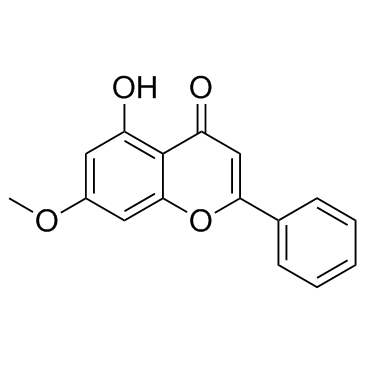520-28-5
| Name | tectochrysin |
|---|---|
| Synonyms |
Methyl chrysin
MFCD00016945 5-hydroxy-7-methoxy-flavone 5-Hydroxy-7-methoxy-2-phenyl-4H-chromen-4-one 5-OH-7-methoxyflavone 7-methoxycrysin Tectochrysin 4H-1-Benzopyran-4-one, 5-hydroxy-7-methoxy-2-phenyl- 5-hydroxy-7-methoxy-2-phenylchromen-4-one Flavone,5-hydroxy-7-methoxy 7-Methoxy-5-hydroxyflavone 4H-1-Benzopyran-4-one,5-hydroxy-7-methoxy-2-phenyl 5-HYDROXY-7-METHOXYFLAVONE Flavone, 5-hydroxy-7-methoxy- 7-O-methylchrysin Techtochrysin NSC 80687 |
| Description | Tectochrysin (Techtochrysin) is one of the major flavonoids of Alpinia oxyphylla Miquel. Tectochrysin (Techtochrysin) inhibits activity of NF-κB. |
|---|---|
| Related Catalog | |
| Target |
p50 p65 |
| In Vitro | Tectochrysin (Techtochrysin) inhibits activity of NF-κB. Tectochrysin (Techtochrysin) binds directly to the p50 unit. Tectochrysin (Techtochrysin) concentration-dependently inhibits the translocation of p50 and p65 into the nucleus through inhibition of the phosphorylation of IκB. To assess the inhibitory effect of Tectochrysin on cell growth of colon cancer cells (SW480, HCT116), cell viability is analyzed by MTT assay. The cells are treated with varying concentrations of Tectochrysin (Techtochrysin) (1, 5, 10 μg/mL) for 24 h. Tectochrysin (Techtochrysin) inhibits cell growth in colon cancer cells in a concentration-dependent manner. Tectochrysin (Techtochrysin) inhibits SW480 cells growth with IC50 value of 6.3 μg/mL and HCT116 cells growth with IC50 value of 8.4 μg/mL. Morphologic observation shows that the cells are reduced in size by the treatment of NSC 80687 (10 μg/mL) in SW480 cells and HCT116 cells. However, Tectochrysin (Techtochrysin) is not cytotoxic in the normal CCD-18co cells in the tested concentration by MTT assay. To delineate whether the induction of apoptotic cell death is critical for cell growth inhibition by NSC 80687, changes are evaluated in the chromatin morphology of cells using DAPI staining. To further characterize the apoptotic cell death by Tectochrysin (Techtochrysin), TUNEL staining assays are performed, and then the labeled cells are analyzed by fluorescence microscopy. Apoptotic cells number (DAPI-positive TUNEL stained cells) in SW480 cell is increased to 1 and 58 % by 0 and 10 μg/mL NSC 80687, respectively, and 1 and 54 % by 0 and 10 μg/mL Tectochrysin in HCT116[1]. |
| In Vivo | To elucidate the antitumor effects of Tectochrysin in in vivo, the tumor growth in colon cancer xenograft-bearing nude mice following Tectochrysin (NSC 80687) treatments is investigated. In HCT116 xenograft studies, Tectochrysin (NSC 80687) is administrated i.p. twice per week for 3 weeks to mice with tumors ranging from 200 to 300 mm3 in volume. The mice are weighed twice per week. The changes in body weights between the control and the Tectochrysin (NSC 80687)-treated mice (n=10) are not remarkably different during the experiment. However, On day 21, the final tumor weights are recorded. Tumor weights and volumes in mice treated with Tectochrysin (NSC 80687) at 5 mg/kg doses are 57.9 % and 46.4 % of the vehicle group, respectively[1]. |
| Cell Assay | Each SW480, HCT116, HT-29, A549 and MCF-7 cell line (1×104 cells) is incubated in 200 μL of RPMI 1640, DMEM medium with NSC 80687 (concentrations ranging from 1, 5, 10 μg/mL) in a 96-well flat-bottomed plate in triplicate. After incubation for 72 h at 37°C, MTT diluted in RPMI 1640, DMEM medium are added to each well and incubation is carried out for 90 min. The supernatant is then discarded and the crystal products are eluted with DMSO (200 μL/well). Colorimetric evaluation is performed with a spectrophotometer at 540 nm. The apoptosis assay is first performed by using DAPI staining. SW480 and HCT116 human colon cancer cells are cultured with concentrations of NSC 80687 (5 μg/mL), and induction of apoptotic cell death is evaluated after 24 h. Tunel assay is done[1]. |
| Animal Admin | Mice[1] Five-week-old male BALB/c athymic nude mice (n=10/group) are used. HCT116 cancer cells are injected subcutaneously (1×107 cells/0.1 mL PBS/animal) into the lower right flanks of mice. After 14 days, when the tumors have reached an average volume of 200-300 mm3, the tumor-bearing nude mice are intraperitoneally injected with Tectochrysin (NSC 80687) (5 mg/kg dissolved in 0.1 % DMSO) twice per week for 3 weeks. The tumor volumes are measured with vernier calipers and calculated[1]. |
| References |
| Density | 1.3±0.1 g/cm3 |
|---|---|
| Boiling Point | 487.4±45.0 °C at 760 mmHg |
| Melting Point | 166-168ºC |
| Molecular Formula | C16H12O4 |
| Molecular Weight | 268.264 |
| Flash Point | 186.8±22.2 °C |
| Exact Mass | 268.073547 |
| PSA | 59.67000 |
| LogP | 3.13 |
| Vapour Pressure | 0.0±1.3 mmHg at 25°C |
| Index of Refraction | 1.641 |
| Hazard Codes | Xi |
|---|---|
| Risk Phrases | R36/37/38 |
| Safety Phrases | 26-36/37/39 |
| HS Code | 2914509090 |
| HS Code | 2914509090 |
|---|---|
| Summary | HS:2914509090 other ketones with other oxygen function VAT:17.0% Tax rebate rate:9.0% Supervision conditions:none MFN tariff:5.5% General tariff:30.0% |


